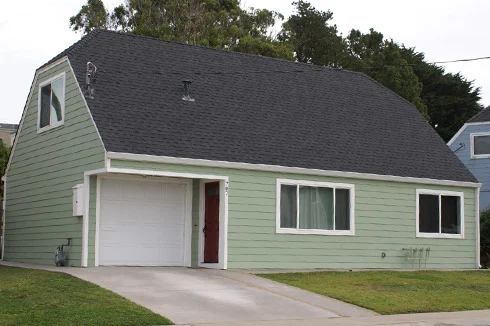- The FHA insures both fixed- and floating-rate loans
- Get a FHA rehabilitation loan for distressed properties.
Learn the Strengths and Weaknesses of FHA Mortgages, and What the FHA Offers Today.
Editor’s note: FHA Mortgage Insurance Premium Changes starting April 9, 2012 and June 11, 2012. There is good news and bad news regarding the FHA MIP (Mortgage Insurance Premium) rates depending on the type of loan you are taking:
- Streamline Refinance Loan: The good news is that the mortgage insurance for FHA Streamline Refinance loans is decreasing starting June 11, 2012. The Up-front Mortgage Insurance Premium (UFMIP) rate decreases to 0.01%, instead of 1%. The annual MIP will be set at 55 bps instead of 115 bps, regardless of the loan amount. That means a savings of $50 per month for every $100,000. This decrease is only available to borrowers whose current FHA loan was delivered to the FHA prior to June 1, 2009.
- Single Family Mortgage Loan: The bad news, which will affect new home purchasers and refinancers with a non-FHA loan, is that the rates, starting April 9 2012 are increasing. The UFMIP increases to 1.75% instead of 1%. The annual MIP will increase by 10 bps.(That means an additional $8.33 per month for every $100,000). The increase in the rates was a result of the Temporary Payroll Tax Cut Continuation Act of 2011 signed by President Obama on Dec. 23, 2011.
Purchasing a home with an Federal Housing Administration-insured mortgage provides many benefits to a homebuyer. One of the biggest is the low down payment that is required for an FHA loan. When purchasing a home FHA allows for first time homebuyers to have a down payment as low as 3.5%. Furthermore, it is easier for a borrower to qualify for a loan that is insured by FHA. For instance, the credit qualifying restrictions are less stringent in an FHA loan than in a conventional loan. This makes an FHA loan the best option for a borrower with less than stellar credit. FHA loans also come at competitive rates.
FHA loans have been in a process of change for the past several years. These changes have made some consumers skeptical, but there really is not much to fear. In fact, an FHA loan today resembles most other mortgage products, but has a few advantages others lack. If you want to find out if an FHA loan is right for you, you must look at the facts.
Similarities of FHA Loans Today
- Minimum Credit Scores: Like any other loan, FHA loans now require a minimum credit score.
- Loan Lengths: FHA loans carry the same term or loan length as conventional fixed rate mortgages.
- Documentation: New standards on documentation required for regular mortgages also apply for FHA loans. Expect to be asked to show all your financial documents, regardless of the type of mortgage you are looking for.
Differences of FHA Loans Today
- Small Down Payment: Generally speaking, FHA loans require a 3.5% down payment, which is smaller than other mortgages. This can be a huge advantage to those without much cash on hand, but who have sufficient income to comfortably make the monthly housing payment.
- Lower Credit Score: While a minimum credit score is required for an FHA loan nowadays, the requirement is still much lower than for a conventional loan. The FICO number is set at 580, with two years of credit history. Those who are seriously considering owning a home should already have a higher score than this.
- More Options: FHA loans offer refinancing options for underwater mortgage holders (those who owe more than their home is worth) who have continued to stay current on their loans. Sourcing these different mortgage products may be the solution you have been looking for.
203(k) Rehabilitation Loan
Buyers of distressed properties may qualify for a rehabilitation loan that includes both the mortgage and the repair costs. The application must include a detailed proposal showing the scope of the work, and a detailed cost estimate for each repair. The appraisal estimates the value of the home after the repairs, rather than the current value.
The required down payment is 3.5% of the total loan, not 3.5% of the current value. The loan then covers the purchase cost, closing costs, and remodeling costs, plus a 10-20% reserve for additional repairs added later or cost overruns. Funds are paid into an escrow account, which is then used to pay the contractor and includes a 10% holdback. Payments on the loan begin immediately after the purchase is complete. Because a borrower may not be able to occupy the home until after the repairs are completed, it is possible to include up to six months of principal and interest payments on the new loan into the total loan amount.
Non-Occupying Co-Borrower on FHA Loans
FHA loans allow as a co-borrower someone who is not going to reside in the home. The FHA program is far more liberal in this circumstance than conventional loan programs. In general, the non-occupying co-borrower is a close relative of the borrower. The non-occupying co-borrower needs to meet certain income and credit qualifications.
There are other types of FHA loans, aside from purchase loans. FHA loans are available for refinance and if someone already has an FHA loan, the FHA streamline refinance can be a simple and quick way to lower one's interest rate at a low cost. An FHA streamline refinance does not require an appraisal, for instance.
Summary
The FHA loan programs are ideal for someone who has less than perfect credit, whose credit issues do not allow him/her to qualify for a low-rate conventional loan. Even a bankruptcy that was discharged two years ago does not preclude a borrower from qualifying for a FHA loan. FHA purchase loans require a low down payment, whereas the days where conventional loans allowed a purchase with little or no money down are gone.
